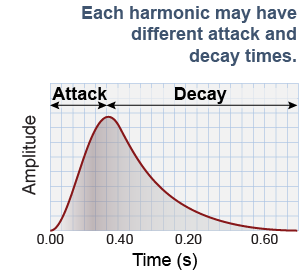|
Different instruments have characteristic sounds just as different people have characteristic voices. As an example, the note E-330 Hz played on a guitar is recognizable as the same note when played on a piano. This note, however, sounds quite different when played on the two instruments. What is different and what is the same? The answer involves the properties of resonant objects and cavities. 
|

|
The sound from a musical instrument is not a single pure frequency but contains many frequencies. The most important are harmonics. A harmonic is a frequency that is an integer multiple of the fundamental. Strings and air columns can vibrate at many harmonics. A real resonant oscillation in an instrument contains many harmonics at once. There are more than 40 distinct harmonics present in the note from a piano! The distinctive sound of an instrument results from: - the relative amplitude of each harmonic compared to the fundamental and
- how quickly each harmonic grows and decays after a note is struck.

In the guitar and piano spectra above, the fundamental frequency is the same but the third and fourth harmonics have different amplitudes. The guitar has a strong third and weak 4th and the piano has a weak third and strong fourth. The same 330 Hz fundamental is the reason why both notes sound like “E,” and the difference in harmonics explains why the guitar sounds like a guitar and the piano sounds like a piano. 
|
 The rate at which the loudness of each harmonic rises and falls is another characteristic that makes an instrument’s sound distinctive. The attack time is the time it takes to reach maximum loudness. The decay time is the time over which the sound dies away. Attack and decay times differ for each harmonic, and higher harmonics tend to attack and decay faster. Attack and decay depend on both resonance and damping, and they are very different for each instrument.
The rate at which the loudness of each harmonic rises and falls is another characteristic that makes an instrument’s sound distinctive. The attack time is the time it takes to reach maximum loudness. The decay time is the time over which the sound dies away. Attack and decay times differ for each harmonic, and higher harmonics tend to attack and decay faster. Attack and decay depend on both resonance and damping, and they are very different for each instrument. 
| |
| |
|

